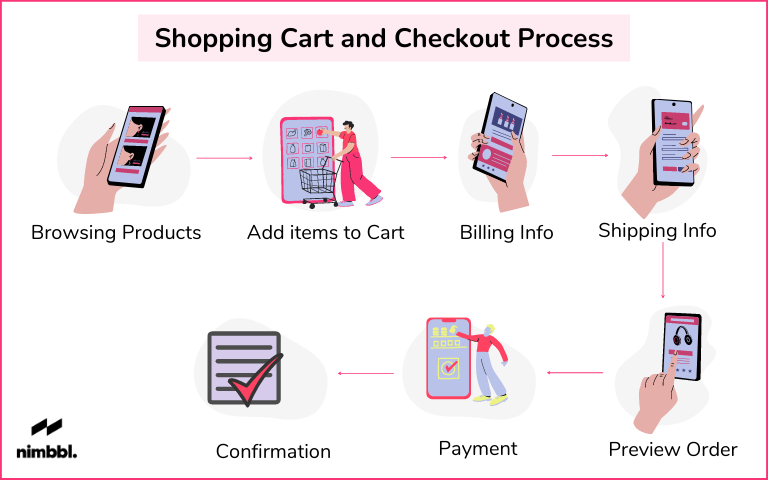Why Does Optimizing an E-commerce Site Matter?
Optimization is crucial for e-commerce as it plays a vital role in user experience, sales, and overall business success. In highly competitive online marketing like e-commerce, optimizing e-commerce websites helps customers to find the products easily, navigate smoothly, and help secure transactions. This not only increases your site performance, but also increases customer loyalty and brand value of your site.
This helps to increase high conversion rates, increase brand loyalty, and better customer satisfaction.

Tips for intuitive navigation, mobile-friendliness, and page speed.
To enhance the user experience, it is important to focus on intuitive navigation by providing clear categories, sub-categories, and having a search bar. Ensuring mobile-friendly designs and checkouts is essential for a successful e-commerce site. You can watch some demo website links of Amazon, Shopify.
1. Intuitive navigation.
- Clear categories: Organising products into categories and subcategories helps users to find their desired goods.
- Search Bar: Including the functional Search bar in your sites helps users to search for their desired products easily.
- Consistent Layout: By placing key elements (main menu, carts, account icons) on top of the page for easy access.
Example: Amazon’s homepage has a clear, intuitive navigation as it contains categories and subcategories of similar types of Products.
2. Mobile-Friendliness.
- Responsive Design: By making your sites responsive on all screen devices, you help to ensure your site content is easily readable on both mobile and desktop screens.
- Touch-Friendly Elements: Ensuring your links and buttons are of proper sizes on different devices helps to avoid accidental clicks.
- Mobile-Optimised Checkout: Fluent checkout process on mobile devices and using mobile-friendly payment options like eSewa, fonepay, Khalti.
Example: Apple’s website is designed in a way that it is compatible with both mobile and desktop screen devices.
3. Page Speed.
- Optimised Images: Optimize the E-commerce site’s images by compressing or using next-gen formats like WebP to reduce the load time without reducing the quality of the images.
- Minimize HTTP Requests: Reduce the number of websites by minimizing the HTTP requests and using very few plugins.
Example: Google Store used highly optimized images in a next-gen format like WebP, which helps the page to load faster, which increases the Page Speed.
Checkout Process Tips.
A dedicated, streamlined checkout process is a must to increase conversions and improve users’ experience. Simplifying the steps of the checkout process includes a clear order summary before the final submission. This helps to increase the user experience and helps to optimize the e-commerce website.

- Guest Checkout: By allowing users to make checkout without creating an account, to speed up the payment process.
- Simplify Steps: Minimising the number of steps in the checkout process helps to reduce friction and make a seamless transaction.
- Auto-Fill Forms: Use auto-fill for address, name, phone_number, etc save time for the payment process.
- Multiple payment Options: Provide Multiple payment options: Provide multiple payment options (eSewa, Khalti, fonepay) for convenience, which helps users to pay from any payment option they like.
Example: Multiple e-commerce websites like Amazon, Alibaba, Daraz have a seamless checkout process and have multiple payment gateway options available.
Product Description Tips.
A simple but convenient product description should be included in straightforward language. Including relevant keywords is necessary for the product description. Product description should be simple and easy to understand.
- Be Clear & Concise: Use straightforward language to describe the product details, highlighting its key features.
- Focus on Benefits: Instead of just giving the features, explain how the product will solve the users’ requirements and problems.
- Include Keywords: Integrate relevant keywords related to those topics to improve the SEO and help to search for products easily.
- Add Specifications: Include the product details like its colours, sizes, and descriptions.
- Use High-Quality Images: Adding high-resolution images helps to provide a complete view.
- Tell a Story: If applicable, tell about the product’s origins or story to create a connection with customers about that particular product.
- Use Bullet Points: Organise the key features and benefits in bullet points as possible.
Example: Amazon provides a clear and a simple clear and concise product description of all the products it sells.
SEO Tips for E-Commerce.
SEO(Search Engine Optimization) helps to boost your website site rank and helps to increase more users on your site. By implementing SEO techniques, you can rank your website and increase traffic on your site.
- Keyword Research: Identify the relevant keywords for your sites that users mostly search for your products. You can use different tools like Google Keyword Planner or SemRush for keyword research.
- Use Alt Text for Images: Describe the Image name with relevant keywords in the alt text to improve image search ranking.
- Mobile Optimization: Ensure your website is mobile-friendly because search engines prioritise the mobile optimization sites.
- Speed Optimization: Improve your site speed by compressing images, minimising code, caching & using fewer Plugins.
- Build Backlinks: By creating or building high-quality backlinks from reputable sites, to can increase your domain authority and increase search ranking.
- Use Schema Markup: By implementing structured data, to can enhance the search result with rich snippets helps to provide complete information to users at a glance.
- Optimized Product Page:
- Title Tags: Include the primary keyword in your title to increase the search visibility.
- Meta Description: Adding a Meta Description with keywords helps to increase click-through from the search results.
8. Use Schema Markup:
- URL Structure: Use clean and descriptive URLs that include keywords (e.g., https://gripasmarketing.com/services/social-media-marketing-nepal/).
- Internal Linking: Linking with the related products and categories helps to crawl your site and increase user navigation.
Conclusion.
In today’s competitive market, optimizing an e-commerce site is not just an option, but also a necessity for increasing your site performance, user experience, seamless checkout process, and much more. This not only improves customer satisfaction but also builds your site’s trust, increases conversion rates, and brand loyalty. As you implement these strategies, continuously monitor your sites to the changing consumers’ needs to stay ahead in the evolving e-commerce market. Investing in optimization today will pave the way for great success tomorrow.


